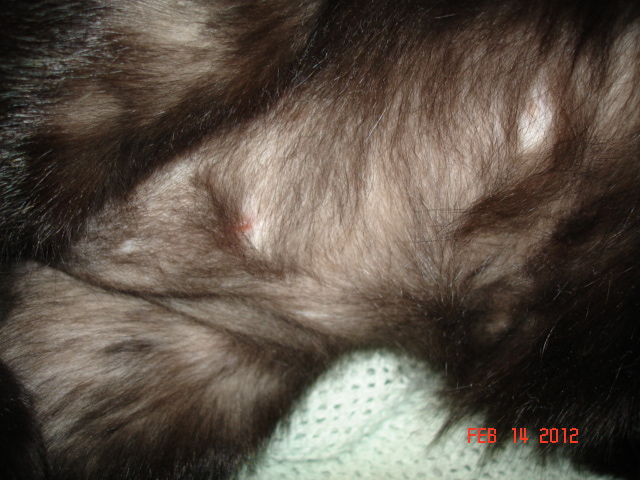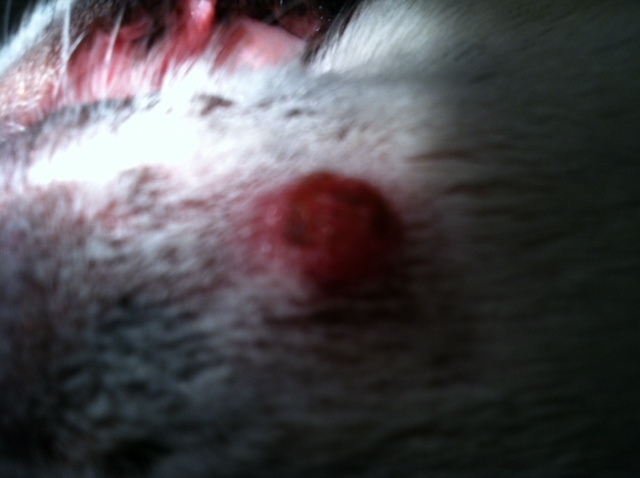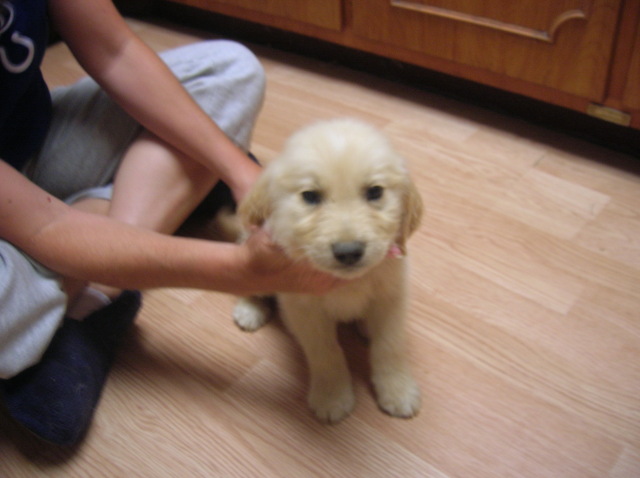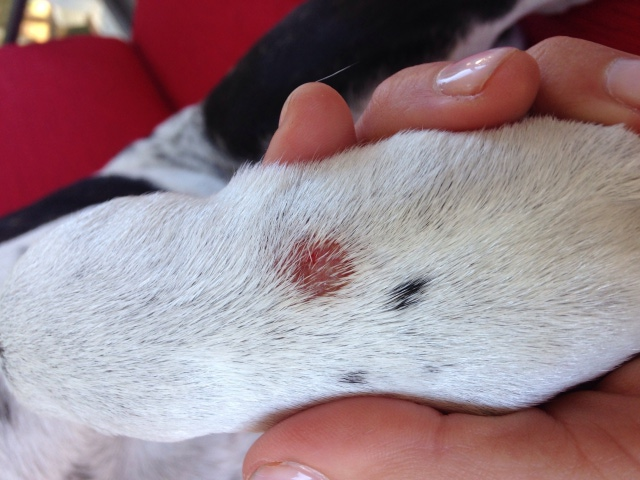QuestionDear Nicole,
I have an 11 yr.old male shar-pei who has just over the past week or so, been experiencing a sudden onset of pain.(while resting) He was resting quietly in another room today, when all of a sudden I heard him yelping loudly. When I ran to him he was continually yelping and holding up his front right leg and walking about the room, pacing back and forth. After about a minute, he stopped yelping, was on all fours and laid down, as if nothing happened. I've noticed over several months now that when he walks he seems to not walk normally straight, but kind of sideways, (noticeably in the rear and hind legs) if you know what I mean. I also have noticed when he goes to lay down he swings his hind legs in a manner so when he lays down, he rests on his rear bottom/side of his body. I have suspected arthritis for a long time now. Other than this, and the sudden onset of pain he's just started having, he is ok; eating, drinking and going outside to do his business, normally. Could you tell me what could be wrong with him? Also could you tell me if there is an over the counter pain reliever I can give him? My husband is being stubborn and says he cannot see spending money on a dog he thinks will not be around much longer. However, I will take him to a vet if you think, by the symptoms I have given you, that his life may be in grave danger. Your opinion would be much appreciated. Thank you.
AnswerHi Shel!
Puppies and kittens play like athletes. They chase toys, tunnel through briars, and leap up each morning ready to start a new day.
As pets get older, however, their joints get a little creaky, and their backs stiffen up a bit. Plus, they have probably put on a little weight, which puts additional stress on tired joints. Eventually, some older pets begin having trouble moving or even getting up.
If your pet is generally in good health, difficulty getting up is probably caused by arthritis. Years of chasing Frisbees or climbing trees can cause joints to break down, a condition that vets call osteoarthritis or degenerative joint disease. Dogs and cats can also get rheumatoid arthritis, though not as often as people do.
Since pets do a lot of twisting and turning, both of which put a lot of stress on the back, arthritis of the spine is especially common. A lot of dogs hurt their knees when they twist around at a full run. Injured joints can show signs of arthritis within a month.
Another condition that makes getting up difficult is hip dysplasia, a hereditary problem that literally means "badly made hips". When the hipbones don't fit together the way they should, pets can get sore and stiff. Any dog can get hip dysplasia, but it is more common in certain breeds of large dogs like German shepherds and Labrador and golden retrievers. Cats can get hip dysplasia, too. Persians are particularly prone to it. But because cats are well-muscled and relatively light, it usually doesn't bother them as much as it does dogs.
Finally, dogs and cats with internal illnesses like diabetes or cancer may have trouble getting up. To tell the difference between joint problems and more serious conditions, take a look at how well your pet is feeling. If she is eating well and seems happy and the stiffness has been coming on gradually, she probably has joint problems. But if the stiffness came on all at once, or she is losing her appetite or feeling under the weather, something more serious may be going on, and you should call your vet right away.
See Your Vet If...
Your pet is elderly or overweight
The stiffness is mainly in her hips
The discomfort came on suddenly
Your pet hasn't been eating well and appears to be ill
Your pet has begun having trouble walking, getting up, or climbing stairs
One or more legs is dragging
He has a limp that doesn't go away
One or more legs is in an awkward position
There is swelling in the toes, feet, or legs
Your pet can't get up
Your pet is constantly licking or biting his feet
The nails are broken, cracked, or bleeding
There are cuts, blisters, growths, or burns on his paw pads
Your pet is lame first in one leg and then another
He has pain when jumping off a bed or changing position
It is easy to give cats or small dogs a little boost when they need help getting up. For larger pets, however, lifting them up can be a challenge. Vets recommend slipping a towel beneath your pet's belly and giving a gentle lift. Most pets with arthritis can move fairly well once they get their stiff hind legs off the ground.
Dogs that have arthritis will sometimes have trouble raising their hind feet high enough to get over curbs or up a few steps. You can give a helping hand simply by using her tail as a handle. Grip the tail close to her body and gently lift her while she moves. As long as her tail is in good condition and you do this gently, she will appreciate the extra help.
Dogs and cats that are overweight are much more likely to have joint problems than their thinner friends. If your pet is getting pudgy, helping her shed a little weight will make it easier for her to jump out of bed in the morning. Here is what you need to do:
Reduce the calories that she is taking in. Vets recommend switching to low-calorie foods, which are available from vets and pet supply stores. You want to buy a food that contains about 35 percent fewer calories than her usual chow. Ask your vet which foods would be the best choices, he advises. The food should also contain more fiber, since fiber will help your pet feel full and satisfied even when she is getting fewer calories.
Make changes gradually. If your pet is too attached to her current food to comfortably make the change, you will have to scale back the servings. Measure how much she usually eats in a day and then give her 10 percent less.
Help keep her satisfied. Dogs and cats take mealtimes very seriously, so don't be surprised if your pet seems unhappy when she first begins her new diet. To keep her stomach satisfied, you may want to add a few green beans, carrots, or some canned pumpkin to her diet. These foods are low in calories and high in fiber, which means that she can eat a lot of them without gaining weight.
Cut back on snacks. The best diet in the world can be destroyed by snacking, so crank up your willpower and quit doling out treats. At the very least, make sure that the snacks are healthy ones, like vegetables or small amounts of high-fiber dry cereal. Pet supply stores sell a variety of dog treats that are labeled "low-calorie." Unfortunately, they aren't as low in calories as you might think, so don't use a lot of them.
Take it slowly. Losing too much weight too quickly can be dangerous, especially for cats. Losing about 1U2 pound a month is a good rate for cats. Dogs can lose weight a little faster -- about 2 percent of their weight per week. So if you have a 100-pound dog, she can safely lose 2 pounds a week.
Vets aren't sure why, but puppies that are given foods low in protein and fat are less likely to develop serious arthritis in their hips than dogs that are eating high-fat-and-protein foods. Look for foods labeled "for large-breed puppies," which are available from veterinarians and in pet supply stores. These foods are formulated to give at-risk dogs the best chance to grow correctly.
Regardless of what your pet eats, regular exercise -- walking and swimming are particularly good -- can be very helpful for easing the aches and helping her get up easily again. Exercise strengthens muscles around the joints, helping them work more efficiently. At the same time, it causes the joints to produce more synovial fluid, a lubricating fluid that acts like oil on a rusty hinge, helping quiet creaks and squeaks. Even pets with advanced hip dysplasia often get better once they start exercising.
Vets recommend that most pets -- including those with arthritis -- get at least two exercise sessions a day for 10 to 15 minutes each. If your pet has been hurting lately, however, be sure to start slowly. Vets recommend starting out by hiking on soft trails or simply walking around the yard. As she gets in better shape, you can increase the intensity of her workouts.
Applying warm, moist heat is an excellent strategy for relaxing stiff joints. Vets recommend giving dogs a 10-minute soak in a warm bath. An easier strategy for dogs and cats may be to wrap a hot-water bottle in a towel and lay it on the sore joints for 5 to 10 minutes, at which point they will usually be feeling a little better.
Don't use electric heating pads. Not only do they dry the skin, they can also get very hot. If your pet is having trouble getting up, she may be unable to move away from the heat when she starts getting uncomfortable.
Massage can be very helpful because it improves circulation to arthritic joints, keeping the muscles limber. When giving a massage, use firm, circular motions, putting pressure on the surrounding muscle and not on the bone itself. Squeeze the muscle gently between your thumb and fingers. If your pet squirms or pulls away, try using a little less pressure. When you have the right touch, she will relax and look happy.
One way to help your pet get up more easily -- a way that she is sure to enjoy -- is to give her a comfortable bed. At the very least, you should provide a pile of thick, warm blankets to sleep on. Or you can buy an orthopedic bed that is made for pets. These beds have dense, foam padding, which cushions joints and helps retain body heat so that the joints stay warm and mobile.
If your pet is having a lot of pain, vets sometimes recommend giving over-the-counter pain relievers. I usually start dogs on a coated aspirin (like Ascriptin. The usual dose is 10 milligrams per pound of pooch, given once or twice a day. Your vet will let you know if this is the right dose for your pet. Aspirin and other over-the-counter pain medicines can be dangerous for cats, however, and shouldn't be used without a veterinarian's supervision.
Finally, there are many nutritional supplements that veterinarians have found may help ease pain and inflammation caused by hip dysplasia and arthritis.
A supplement called superoxide dismutase can be very helpful, particularly when given in combination with vitamins E and C and the mineral selenium. This supplement is available in health food stores, but you will need to ask your vet for the correct dose for treating your pet.
Other supplements that you may want to try include glucosamine and chondroitin sulfate. Glucosamine may be found alone or in combination with chondroitin sulfate. The usual daily dose is 10 milligrams of glucosamine per pound of weight; divide this daily dose in half and give it twice a day.
These and other nutritional supplements are safe, although you will want to check with your vet about the proper dose. Don't expect dramatic results overnight, she adds. You will need to use them for two or three months before you notice a lot of improvement.
Since difficulty getting up may be a sign of serious illness, it is important to see your vet as soon as you start noticing problems.
In most cases, your vet will agree with your hunch that arthritis is the problem. He will probably recommend x-rays to find where the bad joints are and to see how serious the damage is. In addition, he may take a blood sample to test for kidney or liver damage, high blood sugar levels, or infections. He may draw a little fluid directly out of a joint for additional tests.
An increasing number of vets have started using acupuncture to relieve the pain of arthritis and hip dysplasia. Most dogs and cats don't mind the treatments, and it can provide long-term relief, particularly when used in combination with prescription or over-the-counter medications.
If your pet reaches a point where she simply can't get up without assistance, your vet may recommend surgery to repair the joint. In some cases, surgeons can rearrange bones in the hips so that they fit together more precisely. They can also replace the original hip with a brand-new metal one.
A few common causes of leg, hip, and paw conditions are allergies, arthritis, cruciate ligament injuries, hip dysplasia, immune system problems, lick granuloma and luxating patella. Learn more about these common conditions now.
Allergies
Pets suffer from allergies when their immune systems respond to common things like pollen or food in the same way that they respond to aggressive viruses or bacteria -- by attacking.
People with allergies often have runny noses or digestive complaints, while pets tend to itch. The itching can affect the whole body, although certain kinds of allergies -- especially allergies to food and pollen -- tend to affect the paws. To get relief, dogs and cats will lick or bite their paws, sometimes for hours at a time. Eventually, the paws may become wet, red, and swollen. In severe cases, they will even develop painful sores that take a long time to heal.
There isn't a cure for allergies, but they can be controlled. The obvious solution, of course, is to help your pet avoid whatever it is that is making him itch. In the case of food allergies, for example, switching foods will resolve the problem. But it is almost impossible to avoid other common allergens, like pollen or house dust. That is why your vet will probably recommend ways to ease the symptoms, such as using cool soaks for itchy feet or giving your pet antihistamines. (Your vet will recommend a brand of antihistamines and dose that's right for your pet.)
When allergies are severe, your vet may recommend giving your pet a brief course of medications such as steroids, which suppress the immune system. Or he may advise that your pet undergo a series of shots that will make him less sensitive in the future.
Arthritis
Meaning "inflammation of a joint," arthritis is among the most common causes of pain in dogs and cats. There are many types of arthritis, but the kind that usually affects pets is osteoarthritis, or "wear-and-tear" arthritis.
Osteoarthritis occurs when soft cartilage inside a joint becomes inflamed, usually as a result of years of normal daily motion. The inflammation gradually damages bones in the joint, causing them to form ridges, grooves, or even bits of new bone called spurs. The spurs interfere with the joint's normal movements, causing pain and even more inflammation.
Other kinds of arthritis can be caused by infections or problems with the immune system. Pets with Lyme disease, for example, can develop very painful arthritis. So can dogs and cats with lupus, a serious immune system disorder.
If caught early, some forms of arthritis, such as those caused by infections, can be cured entirely by treating the underlying problem. In most cases, however, the only solution is to treat the symptoms. Your veterinarian has several good choices for pain control that are safer and more effective than over-the-counter drugs. (These include prescription pain relievers as well as alternative therapies such as acupuncture.) In addition, he may recommend medications that increase lubrication in the joints as well as drugs that can speed the repair of damaged cartilage, making it stronger and more flexible.
Cruciate Ligament Injuries
The knees are held together by tough muscular straps called cruciate ligaments. These ligaments are extremely strong and resilient, but they aren't invincible. Sometimes they get torn, which causes pain and allows the knee joint to slide back and forth like a dresser drawer.
This type of injury is rare in cats but is fairly common in dogs, particularly when they are having a good time playing with other dogs. He might run and turn wrong or get a hard blow to the knee, just like in football. If your dog comes home limping after fun and games or he is unable to put any weight on one of legs, he could have this type of injury.
Minor tears in the ligaments will often heal with rest and perhaps physical therapy. When the tear is severe, however, your dog may need surgery to repair it. Unfortunately, he is unlikely to have the relatively easy kind of surgery, called arthroscopic surgery, that is commonly used on humans. Knee surgery in pets usually requires a long surgical incision and a day or two in the hospital. After the surgery, however, the knees usually heal completely and quickly.
Hip Dysplasia
Many breeds of dogs have hip joints that don't fit together the way they should. This condition, called hip dysplasia, occurs when the ball of the hip doesn't smoothly match the opposing socket. As a result, the joint grinds and wobbles. Over time, this wobble causes wear and tear on the joint, eventually leading to painful arthritis that makes it difficult for pets to move.
Hip dysplasia is a genetic disease, meaning that it is passed from generation to generation. It is most common in large-breed dogs like German shepherds, golden retrievers, and Labrador retrievers. Cats can also get hip dysplasia, but because they are so small and light, they don't usually hurt because of it.
Our main treatment for hip dysplasia is controlling pain because you can't cure the disease. When the problem is severe, however, surgery may be needed to repair or even replace the hip. The procedure can be quite successful.
For young dogs that either have hip dysplasia or are likely to get it, vets recommend regular exercise because it tightens the joint by strengthening the surrounding muscles. In addition, vets sometimes give medications that increase the amount of lubricating fluid around the joint, which can help reduce the pain.
Immune System Problems
The immune system is your pet's first line of defense against a variety of health threats, from bacteria and viruses to cancer cells. But sometimes it starts turning its formidable powers inward.The immune system can get confused and think that part of its own body is a foreign invader.The attack begins and the body, which is really an innocent bystander, gets blasted.
There are a number of immune system problems, called autoimmune disorders, that affect the legs, hips, and paws. Pets with autoimmune disorders such as pemphigus and lupus may develop thick, split, or sore paw pads. The nails may get flaky or brittle, and the nail bed can get infected. In addition, pets with these problems often feel sick generally. They may have skin problems as well as painful joints.
Treatment for autoimmune disorders is aimed at getting the body's natural defenses to stand down. Medications such as steroids, gold salts, tetracycline, or niacinamide will partially suppress the immune system, making it less likely to attack its owner.
Lick Granuloma
Dogs are a lot like people: Once they do something for long enough, it can be very hard for them to stop, even when the behavior is doing them harm.
People sometimes get in the habit of pulling their hair or smoking cigarettes. Dogs, on the other hand, may get in the habit of licking their feet. At first they do it for a good reason -- because they have allergies, for example, or flea bites that itch. But even when the original problem is gone, they can't stop the habit and may continue chewing and licking. They will do it for so long that the skin can develop painful sores called granulomas. Cats can develop compulsive behaviors of their own, but they rarely get this condition.
To prevent your dog from getting "addicted" to licking, it is important to act quickly and stop whatever is making him itch. This might mean using flea collars, for example, or keeping him indoors when pollen counts outside are highest. If your pet is already itchy, cool-water soaks can be very soothing. So can moisturizers and anti-itch creams, which you can get from your vet or pet supply stores.
Once pets have developed lick granulomas, it can be a challenge to get rid of the sores. Dabbing moisturizers on them may be helpful. If the sores are infected, applying a triple-antibiotic cream can help them heal. (Pets will often lick ointments off before they have a chance to work, so your vet may recommend oral medications.) In addition, your vet may advise that you give your dog fluoxetine (Prozac) or other mood-altering medications, which will make him calmer and more secure -- and less likely to lick himself excessively in the future.
Luxating Patella
A luxating patella is simply a kneecap that regularly pops out of place. The thighbone and shinbone, which meet to form the knee, have deep grooves that allow the kneecap to slide smoothly back and forth. If the grooves aren't formed properly or have been damaged, the kneecap may periodically jump off its tracks. When this happens, your pet won't walk smoothly but will actually skip a few steps.
This condition normally doesn't hurt and is usually more of an annoyance than an immediately serious problem. In the long run, however, it can cause bone damage that leads to arthritis. And in some cases, the kneecap won't slip back into place. That is when surgery may be required.
Luxating patellas are most common in certain small-dog breeds, such as Chihuahuas and poodles, and in some breeds of cats. Since it is an inherited condition, vets usually recommend that pets that have it not be used for breeding.
I hope this has been helpful and I wish you the best of luck!Please keep me posted and give that Shar-pei millions of kisses for me!Sending wagging tails your way!Nicole

 Dull Fur & Flaky Skin
QuestionQUESTION: Can you give your cat the human Omega
Dull Fur & Flaky Skin
QuestionQUESTION: Can you give your cat the human Omega
 Histiocytoma on older dog
Question
Histiocytoma on dog, 1
Our 13 year old
Histiocytoma on older dog
Question
Histiocytoma on dog, 1
Our 13 year old
 Cyst/bump on my cat
Question
Peters lumps/bumps
I have two male neutered Si
Cyst/bump on my cat
Question
Peters lumps/bumps
I have two male neutered Si
 thank god for your sweet heart
QuestionRiley
QUESTION: i feel so much better an
thank god for your sweet heart
QuestionRiley
QUESTION: i feel so much better an
 Where do I begin?!
QuestionGranuloma
Staph
QUESTION: Hello!
Where do I begin?!
QuestionGranuloma
Staph
QUESTION: Hello!